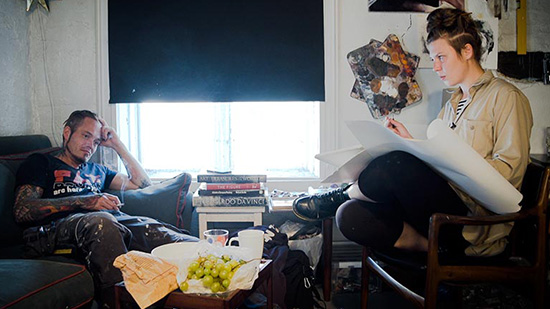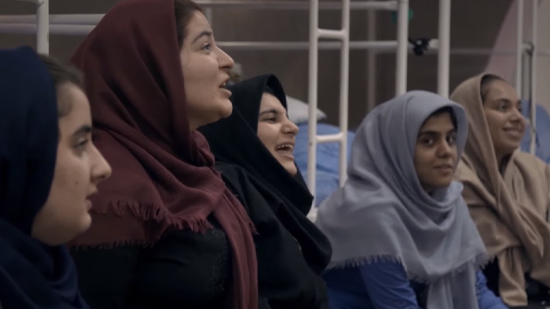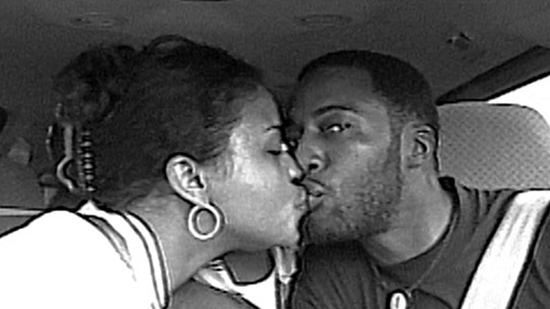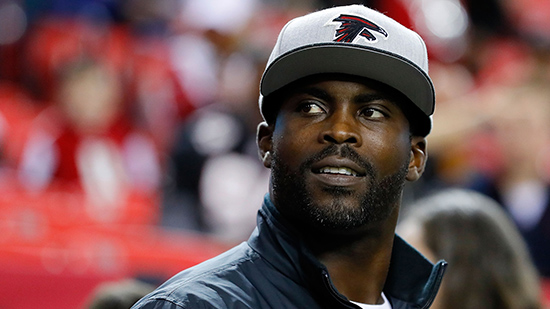The 25 Best Documentaries of 2020

Though the pandemic has all but murdered moviegoing in 2020, for the lowly documentary film, the distribution landscape has never looked more promising. Often relegated to festivals and then, if fortune-favored, Netflix or HBO, documentaries rarely receive the attention or the right platform to reach more than a specialized audience. If it seems like 2020 was a particularly bright year for documentaries, that might be because you could actually watch many of these at home, streaming through virtual cinemas or online festivals or via services like Mubi and Kanopy (off the top of the dome).
In the spirit of such bounty, the following 25 documentaries cover a broad swath of picks: Jodie Mack’s feature-length The Grand Bizarre, which only became widely available this year; the latest from stalwarts of the form, such as Spike Lee, Werner Herzog, Steve James and Frederick Wiseman; Khalik Allah’s 200-minute IWOW and Sky Hopinka’s feature debut, which both seemed like they’d never find their way out of the festival circuit; a 30 for 30 entry that isn’t The Last Dance; a film essay about Showgirls; and a truly mesmerizing, nearly four-hour account of one of the weirdest teams in the one of the weirdest professional sports, told as a hybrid of Ken Burns archiving and PowerPoint presentation, now free to watch on YouTube.
Here are our picks, listed alphabetically, for the 25 best documentaries of 2020:
76 Days
Filmed throughout four Wuhan hospitals in the first two-and-a-half months of the COVID-19 outbreak—as the rest of humanity was only beginning to understand the difference between what was happening a world away and what was to come—76 Days thrums with intimacy and desperation devoid of any sort of political messaging. This is undoubtedly due to Chinese government interference; director Hao Wu (working with Weixi Chen and an anonymous co-director) has talked about the pressure to remove all sense of the government’s response to the building crisis (whether positive or not), focusing entirely on the medical staff and their patients responding to one unprecedented scenario after another, just to get it released at all. But in the vacuum left by the dearth of bureaucratic context, the streets—all of civilization really—surrounding these hospitals seem empirically empty, ghost towns of shuttered life, leaving the doctors and nurses and (mostly) older, poorer patients struggling to breathe the sole inhabitants of a new kind of dystopian afterlife where only a noble few dressed in paper-and-tape hazmat suits can save us from the brink. And yet, quiet moments break from the furor: a cell phone from a dead person, wrapped in plastic and blinking with countless missed calls; a rose drawn by one nurse on another’s paper carapace, like a doodle on a cast to add some grace to the graceless; a call from a son to his aging father, commanding him to be a good Party member and to quit crying—the first glimpses of the devastating burdens we’re still carrying almost a year later. —Dom Sinacola
American Utopia
Three and a half decades since Jonathan Demme empowered Talking Heads to reach the upper echelons of the concert film in Stop Making Sense, Spike Lee drills down into David Byrne’s musical and ideological evolution for the sublime spectacle of American Utopia’s stage show. Byrne is overtly invested here in the journey, exploring a narrative of movement and instrumentation and letting the music flow casually—perhaps because he’s got so much more music under his belt since the last time his voice helped a rock doc soar to the ceiling. He and his barefoot ensemble sing cerebral hymns celebrating synapses and social bonds rather than gods or miracles. Its a humanist spirituality made all the more affecting by Lee’s impeccable camera placements and moves—not to mention some signature Spike stylings none of his joints are complete without. It’s a thematically dense show made all the denser by Byrne’s wry appeals to the audience, at first vague and then searingly specific (you all better be registered to vote now, concert attendees), and the endlessly interpretable nature of the songs. Like its central performer, American Utopia is seemingly indefatigable in its hope and optimism, not only for the future but for those who must shape it. In the face of racist violence, police brutality, an increasingly isolated and polarized society, and more hardships, American Utopia emphasizes empathy. For many, it’ll be one of the best shows they’ve ever been to and for almost all, it’ll be the best of their year.—Jacob Oller
The Annotated Field Guide of Ulysses S. Grant
Jim Finn’s The Annotated Field Guide of Ulysses S. Grant is less concerned with the particulars of its eponym’s legacy than it is with unpacking the fall of the Confederacy and the rotten underpinnings of The Lost Cause. Composed of narration detailing stories alongside Grant’s path liberating the South, modern images of historical sites and stop-motion animation of battle strategy board games, the film appears at first glance a matter-of-fact travelogue. Finn pairs historical anecdotes with quiet, almost picture-book-like images lensed on 16mm, his narration providing the sort of moral clarity one wishes could replace the “state’s rights” strain of history textbooks, though condemning the Confederacy and its white supremacy is a relatively low ideological bar to clear, fascinating as the stories and research may be.
Thankfully there’s more to it: As the contrast between the images and narration starts to develop, Finn arrives at something. He films ruins, monuments and battlefields in their current state, and it is in these visits to places like Stone Mountain up the tram, and stop-motion board games and bubblegum cards, where Finn finds a perspective beyond a corrective history lesson: the cheap commodification of Southern history, sanitized and glazed with a sort of he-man plasticity, revealing the strange ways our culture can present the past as benign myth when its direct effects are still readily observed. On its own, Finn’s arrangement of research remains rich and compelling, subtly exposing the core of The Lost Cause and its legacy. But what makes the film work on a level worth praising are such stories in conversation with images of today’s public presentation of history: the highways where it has been paved with modernity, the gaudy products of myth-making and the silent landscapes where it is at once forgotten and remembered. —Daniel Christian
Songs of the soul flow from the drunken mouths of the jukebox-loving inebriates in Bloody Nose, Empty Pockets. The Ross brothers have created a prototype barroom experience: It is closing night for the fictionalized Roaring 20’s in Las Vegas, a real bar actually operating in their home base of New Orleans, and the regulars, led by local professional actor Michael Martin and otherwise populated with true bar-frequenting non-actors, have come together to kiss their favorite watering hole goodbye. Its much-discussed fictional framework is merely that—a framework—beneath which legitimate human interactions play out, with characters representing themselves and actually drinking the night away. There is authentic war vet commiseration and romantic longing, bartender-led singalongs and, inevitably, one guy trying to fight another “with eyes tattooed on his eyelids.” The holy trinity of dive bar life—despondency, frivolity and pugnacity—is present and spiritually enriching.
As always, the Ross bros depict those before their camera with the deepest care and respect. Pangs of regret and anguish sound between moments of hilarious drunken crosstalk, with Martin’s character pulling in close his younger, rambunctious four-eyed friend and imploring him not to likewise spend his life in a bar. The film runs the gamut of drunken night emotions, from wistful dancing to maudlin bouts of self-loathing, but the mood is never pinned to any specific emotion; it is less about one peak or one valley than it is about creating the shape of a waveform in itself. Yet each crest and trough is tinged with the fleeting feeling of the other: To be low is to be touched by the immense depth of drunken feelings, and to be high is to ride forth in embarrassing obliviousness. But somehow the images never whiff exploitation; they radiate a sense of humanity and an understanding of these American outcasts, who will surely flit from one closing bar to the next. What awaits them thereafter is a mystery, and perhaps a sad story we do not need to know. —Daniel Christian
Boys State
The tendency to read too much into Boys State as a representative of American politics—contemporary, functional, broken and otherwise—doesn’t quite line up with the event itself, in which every year the American Legion sponsors a sort of mock government sleepaway camp in Texas for high school boys (girls get a similar program of their own), where attendees join parties, run for office, craft platforms, run campaigns, hold debates, then ultimately exercise their right to vote. As one candidate for fake boy office explains, “My stance on abortion would not line up with most guys’ out there. So I changed my stance. That’s politics…I think. You can’t win on what you believe in your heart.” Money has no place in their policies, nor do women, immigration, or anything that isn’t gun control or abortion. They aren’t much interested in exploring U.S. governmental systems and lawmaking as they are in reinforcing an ideal of obsolescing democratic rule. There is no representation here, there are only screaming masses of peachfuzz and popularity contests. Instead of taking a divided nation’s temperature through its puberty-ridden youth, Jesse Moss and Amanda McBaine’s documentary becomes a dramatic account of modern American masculinity in the making, blisteringly hormonal and desperate to be taken seriously. —Dom Sinacola
/>
City Hall
The complex and often paradoxical nature of institutions is the definitive interest of prolific documentary filmmaker Frederick Wiseman, and at age 90 he’s released his 46th film, a four-hour-and-32-minute epic examining Boston’s City Hall. Whether in board rooms, on garbage routes or inside Boston apartments, Wiseman reveals the broad scale and impact of city government in all of its glory—when this well-oiled machine works seamlessly, that is—but also highlights the lack of essential services and resources for Boston’s most vulnerable communities and citizens. Wiseman paints intimate portraits of parts of society that on the surface might seem banal and unextraordinary, but are in fact exhilarating in their hidden details. The filmmaker’s verité style of filming allows the viewer to not only be a spectator, but a student of the mechanics of these systems. There are no interviews, narration or text to guide us; instead, we’re completely absorbed in the spaces and interactions Wiseman films, eventually becoming embedded in the institutions he unpacks.
While City Hall is certainly drenched in Wiseman’s trademark style, it is also distinct among the filmmaker’s massive catalogue due to his personal relationship with Boston: He was born and raised in the city and taught at Boston University before his film career. His first film, the 1967 documentary Titicut Follies, depicts the squalid living conditions of the Bridgewater State Hospital at the time, located only 25 miles outside of the city. The filmmaker also took to Boston for the similarly-lengthy 1989 film Near Death, which follows patients and medical personnel in the ICU at Beth Israel Hospital. City Hall feels like a homecoming film for Wiseman in many ways—returning to a city that served as both residence and inspiration for the filmmaker throughout his career. —Natalia Keogan
There is perhaps no film that exudes the collective essence of Steve James’s body of work as much as his latest. City So Real is ostensibly about a Chicago in crisis amid the trial of former Chicago police officer Jason Van Dyke, who was charged with the first-degree murder of Laquan McDonald in 2018, and the crowded 2018-2019 mayoral election. The film’s most immediate charms do not come from navigating these threads, however. For all its outward perspective, it feels more than anything else a film in which James is expressing a very particular and complicated affection for his home city. In that way he synthesizes his finest films.
City So Real retains the sprawling intersectionality of America to Me but reduced to a tidy four hours, and at times echoes the place films of Frederick Wiseman, like Belfast, Maine or Monrovia, Indiana, in its commitment to documenting such a comprehensive array of people, spaces and conversations. James replaces Wiseman’s distance with closeness, using chance encounters with the likes of dog-walkers and Uber drivers to provide essential shading of this multifaceted city portrait. He makes excursions to seemingly every corner of Chicago, highlighted by a graphic that appears on screen to indicate which neighborhood this barbershop, or this dinner party, belongs to. As James weaves between these revealing vignettes and scenes of embedded access with several mayoral candidates, City So Real takes a sweeping look at the public and private lives of Chicago, of the political machine and of everyday sidewalk stories, of life at work and sometimes at home. Exploring racial and cultural contradictions that often lurk just below the surface, James’s camera seems to parse the dissonance and cacophony of city noise to locate each individual voice for a brief moment. Beneath the scaffolding of the election, these brief encounters amass to the point that the minutiae transcends itself. We see a collection of moments that speak to James’s understanding of humanity, often troubled, mundane and optimistic all at once. —Daniel Christian
Collective
Alexander Nanau’s documentary unfolds like a procedural so efficiently, his access so surprisingly unfettered, one can’t help but begin to doubt the horrors exposed. Like three seasons of The Wire adulterated into two hours, Collective begins with the aftermath of a nightclub fire in Bucharest in 2015, which killed 27 people and wounded nearly 180, as parents of victims—both those who perished that night and (many of) those who died in hospitals soon after—begin to gather and question how the Romanian government, top to bottom, seems to be at the heart of such tragic dysfunction. Nanau shows us startling clear video from that night, unflinching and terrible, and then continues to not look away as a group of journalists begin to uncover the corruption that led to so much suffering. Meanwhile, Nanau follows survivors and activists, and then the newly appointed Health Minister (after the other guy resigned for gross incompetence), young and idealistic, as the system crushes every moral step he tries to make, buffeted on all sides by conservative propaganda and the bourgeois class, who have long profited from so much death and misery. The cruelty and perversion of Romania’s governing class should come as no surprise, nor should the results of the election that closes out the film, but Nanau doesn’t frame his drama around the explication of wrongdoings and the punishment of such wrongdoers. He eschews interviews and talking heads for incisive observation, sometimes so intimate it feels like empathy; he returns over and over to the vulnerable people who must endure—their courage, their fear, and the marginal hope they provide the rest of us by simply doing their jobs. It is a testament not to the power of journalism, but to its necessity, one of the last bastions civilization has against normalizing this nightmare here at the End of History. —Dom Sinacola
Crip Camp
Crip Camp, a documentary about a summer camp for disabled teens, is a movie that, in a casual director’s hands, could turn very easily into a piece of exploitation honed in on adversity. But Jim Lebrecht and Nicole Newnham aren’t casual. They’re coworkers, having collaborated on three documentaries together over the past decade and a half, and Lebrecht, who has Spina Bifida, attended said summer camp in 1971. The film is a personal matter for Lebrecht, facilitated with his longtime colleague, and guided by their relationship, Crip Camp functions partly as a portrait and partly as advocacy.
Half of it is spent strolling down memory lane, revisiting either through oral history or archival footage days at Camp Jened in the Catskills, where teenagers with disabilities—deaf teenagers, blind teenagers, teenagers who survived polio, teenagers with cerebral palsy—congregated under the care of hippy counselors. Here the teens, many for the first time in their lives, were treated simply as teens, and not as societal inconveniences. The other half of the movie unfolds against the backdrop of the battle for Section 504, fought in 1977, as disabled Americans, many of them former Jened campers, organized protests and a famous sit-in to persuade Joseph Califano to sign the important regulations into law. The campaign for disabled rights deserves a spotlight for its own merits, as this isn’t really a chapter in history standardly taught in American schools, but the specifics of Crip Camp’s subject speaks to a broader, urgent point about the power of community: When people unite under one banner for a common cause, there’s little they can’t accomplish. A message as timely as it is timeless. —Andy Crump
Dick Johnson Is Dead
If every great documentary is about the responsibility of observation, then Kirsten Johnson’s Cameraperson is also about the fragility of that observation. With her follow-up, Dick Johnson Is Dead, Johnson continues to interrogate that fragility, crafting a deeply personal ode to that over which she has no control: her father’s death. It helps that Dick Johnson is a mellifluous soul, an incessantly warm and beaming man surrounded by friends and colleagues and acquaintances who all uniformly, genuinely love him, but from its opening shots, Johnson makes it clear that her father’s wonderful nature will only make saying goodbye to him that much more difficult. And the time when she must do so looms closer and closer.
Her impetus, she reluctantly acknowledges, is partly selfish as she decides to help acquaint her father with the end of his life, reenacting in lavish cinematic vignettes the many ways in which he could go out, from falling air conditioner unit, to nail-festooned 2×4 to the face, to your run-of-the-mill tumble down the stairs, replete with broken neck. The more Johnson loses herself in the project, spending more effort consulting stunt people and art directors and assorted crew members than her own dad (sitting peacefully on set, usually napping, never being much of a bother), the more she realizes she may be exploiting someone she loves—someone who is beginning to show the alarming signs of dementia and can no longer fully grasp the high concept to which he once agreed—to assuage her own anxiety. As her dad’s memory dissipates along with his ability to take care of himself, Dick Johnson Is Dead caters less to Dick’s need to preserve some sense of immortality than to his daughter’s need, all of our need, to let go. —Dom Sinacola
Cuba may offer unparalleled paradisiacal sights, but, if images from Hubert Sauper’s digital camera are any indication, economic collapse has led to a proliferation of island-hopping Europeans who are breaking the country’s long-held resistance against the sort of imperialistic capitalism that centralizes tourism in caribbean nations’ economies. Sauper approaches this landscape with a meandering look at Cuba’s historical relationship to colonialism, and specifically to the United States, told through discursive visits with Havana denizens and his own musings on the legacy of cinema as a sort of colonial arm itself.
The latter is expressed in myriad ways, including a man with a magician’s top hat showing a theater full of children snippets from Thomas Edison’s 1898 filmed reenactments of the Spanish-American War, footage with a documentary function that positions the United States as liberators. When the stars and stripes are raised on the Cuban beaches, the school children boo, the conflicts of history somewhere between them and the screen. Likewise, footage that appears to depict the explosion of the USS Maine is revealed to be toy boats in a bathtub, and the deathly fumes cigar smoke from the cameramen; “cinema is witchcraft,” he says. Yet Oona Castilla Chaplin, granddaughter of Charlie Chaplin, makes an appearance as a children’s acting coach, strumming a ukulele while students run around her with glee. She screens for them The Great Dictator, and Sauper plays words from the film’s famous final speech (“I don’t want to rule or conquer anyone”) just after another appearance of Edison’s material, briefly pitting an idealistic cinema against a cynical one. If Epicentro seems like a film with a lot on its mind, Sauper lays out the not-quite aimless but certainly scattershot framework up front. Cuba, with all its utopian connotations, has been the epicenter of some of the world’s most dystopian developments. Sauper finds a view of modern Cuba between the contradictions history has forced onto it. —Daniel Christian
-

-

-

-

-

-

-

-

-

-

-

-

-

-

-

-

-

-

-

-

-

-

-

-

-

-

-

-

-

-

-

-

-

-

-

-

-

-

-

-

























































